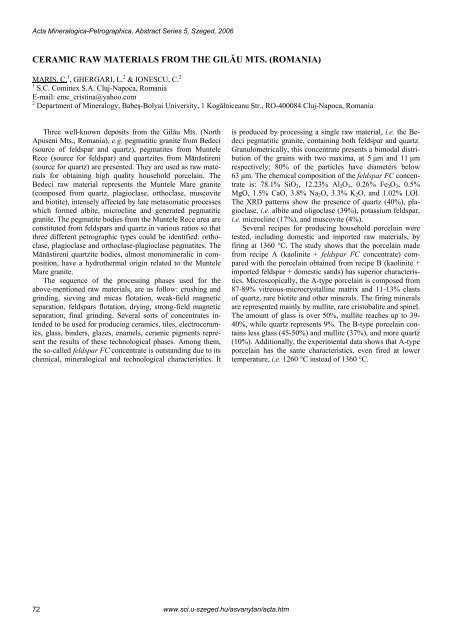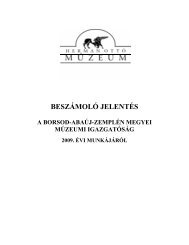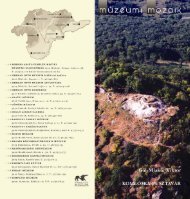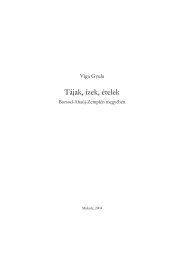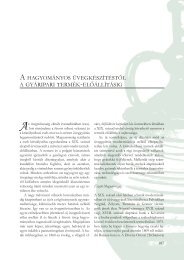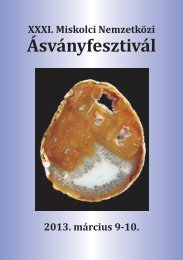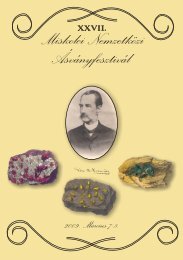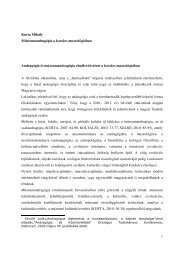Acta Mineralogica-Petrographica, Abstract Series 5, Szeged, 2006CERAMIC RAW MATERIALS FROM <strong>THE</strong> GILĂU MTS. (ROMANIA)MARIS, C. 1 , GHERGARI, L. 2 & IONESCU, C. 21 S.C. Cominex S.A. Cluj-Napoca, RomaniaE-mail: emc_cristina@yahoo.com2 Department of Mineralogy, Babeş-Bolyai University, 1 Kogălniceanu Str., RO-400084 Cluj-Napoca, RomaniaThree well-known deposits from the Gilău Mts. (NorthApuseni Mts., Romania), e.g. pegmatitic granite from Bedeci(source of feldspar and quartz), pegmatites from MunteleRece (source for feldspar) and quartzites from Mănăstireni(source for quartz) are presented. They are used as raw materialsfor obtaining high quality household porcelain. TheBedeci raw material represents the Muntele Mare granite(composed from quartz, plagioclase, orthoclase, muscoviteand biotite), intensely affected by late metasomatic processeswhich formed albite, microcline and generated pegmatiticgranite. The pegmatite bodies from the Muntele Rece area areconstituted from feldspars and quartz in various ratios so thatthree different petrographic types could be identified: orthoclase,plagioclase and orthoclase-plagioclase pegmatites. TheMănăstireni quartzite bodies, almost monomineralic in composition,have a hydrothermal origin related to the MunteleMare granite.The sequence of the processing phases used for theabove-mentioned raw materials, are as follow: crushing andgrinding, sieving and micas flotation, weak-field magneticseparation, feldspars flotation, drying, strong-field magneticseparation, final grinding. Several sorts of concentrates intendedto be used for producing ceramics, tiles, electroceramics,glass, binders, glazes, enamels, ceramic pigments representthe results of these technological phases. Among them,the so-called feldspar FC concentrate is outstanding due to itschemical, mineralogical and technological characteristics. Itis produced by processing a single raw material, i.e. the Bedecipegmatitic granite, containing both feldspar and quartz.Granulometrically, this concentrate presents a bimodal distributionof the grains with two maxima, at 5 µm and 11 µmrespectively; 80% of the particles have diameters below63 µm. The chemical composition of the feldspar FC concentrateis: 78.1% SiO 2 , 12.23% Al 2 O 3 , 0.26% Fe 2 O 3 , 0.5%MgO, 1.5% CaO, 3.8% Na 2 O, 3.3% K 2 O, and 1.02% LOI.The XRD patterns show the presence of quartz (40%), plagioclase,i.e. albite and oligoclase (39%), potassium feldspar,i.e. microcline (17%), and muscovite (4%).Several recipes for producing household porcelain weretested, including domestic and imported raw materials, byfiring at 1360 °C. The study shows that the porcelain madefrom recipe A (kaolinite + feldspar FC concentrate) comparedwith the porcelain obtained from recipe B (kaolinite +imported feldspar + domestic sands) has superior characteristics.Microscopically, the A-type porcelain is composed from87-89% vitreous-microcrystalline matrix and 11-13% clastsof quartz, rare biotite and other minerals. The firing mineralsare represented mainly by mullite, rare cristobalite and spinel.The amount of glass is over 50%, mullite reaches up to 39-40%, while quartz represents 9%. The B-type porcelain containsless glass (45-50%) and mullite (37%), and more quartz(10%). Additionally, the experimental data shows that A-typeporcelain has the same characteristics, even fired at lowertemperature, i.e. 1260 °C instead of 1360 °C.72www.sci.u-szeged.hu/asvanytan/acta.htm
Acta Mineralogica-Petrographica, Abstract Series 5, Szeged, 2006ADA TEPE AND NEIGHBOUR<strong>IN</strong>G GOLD PROSPECTS: SEDIMENTARY-HOSTED,EPI<strong>THE</strong>RMAL DEPOSITS AND OCCURRENCES <strong>IN</strong> <strong>THE</strong> EASTERN RHODOPES,BULGARIAMÁRTON, I. 1 , MORITZ, R. 1 , MARCHEV, P. 2 , BONEV, N. 3 , HASSON, S. 4 & VENNEMANN, T. 51 Section des Sciences de la Terre, University of Geneva, Geneva, SwitzerlandE-mail: Istvan.Marton@terre.unige.ch2 Geological Institute, Bulgarian Academy of Sciences, Sofia, Bulgaria3 Department of Geology and Paleontology, Sofia University “St. Kliment Ohridski”, Sofia, Bulgaria4 Balkan Mineral and Mining AD, Krumovgrad, Bulgaria5 Faculté des Géosciences et de l’Environnement, University of Lausanne, Lausanne, SwitzerlandThe epithermal gold mineralization with a low-sulfidationcharacter at Ada Tepe and surrounding prospects are dominantlyhosted by syn-detachment sedimentary rocks of Maastrichtian-Paleoceneage. The associated dominant structure isa low angle normal fault, named Tokachka detachment fault,which is a major lithological and structural contact betweenthe metamorphic basement and the Maastrichtian-Paleocenesedimentary rocks (BONEV et al., 2005). These newly discovereddeposits are economically significant and open upnew exploration possibilities in this part of the Tethyan MetallogenicBelt. There is presently the potential open pit miningat the Ada Tepe deposit with high grade ore (5.2 Mt @5.0 g/t Au), with a total of 835000 ounces of gold indicatedby Balkan Mineral and Mining (Dundee Precious Metals Inc.,Report on Feasibility Study, 2005). Another prospect at Rosinohas been developed up to the feasibility level with a6.07 Mt of ore but at a lower grade (2.3 g/t Au) estimated byCambridge Mineral Resources Plc. (Press Release, 2005).The Ada Tepe deposit is located along the northern partof the N-NE-oriented Kessebir-Kardamos dome, which is aprominent geological feature in the Eastern Rhodopes. Geologicstructures around the Ada Tepe deposit and adjacentprospects can generally be modelled by domino-style rotationalnormal faulting in the upper plate above the detachmentfault. The importance of structural and lithologicalcontrols is reflected by the geometry of the ore bodies. Theyinclude: (a) strongly faulted rocks of the highly permeableShavar Formation that offered a favorable channel-way forfluid circulation generating open space filling bonanza typemineralization in veins with a general E-W direction; (b) incontrast, the deformed metamorphic rocks with a ductilefabric and the cataclastic deformed detachment zone were theloci for focused fluid flow, toward lower pressure areas,where a massive, tabular ore body, named the “Wall” wasformed immediately above the detachment fault. These zonesconsist of strongly altered rocks, replaced by silica minerals,adularia, sericite, pyrite and carbonate minerals. They formedthrough total replacement of the original metamorphic mineralsincluded as clasts in conglomerates, and are associatedwith relict quartz and muscovite.The ore mineralogy is simple, and consists of electrum(~75% Au), subordinate pyrite (more abundant in Surnak)and traces of galena and tellurides. The gangue is comprisedof chalcedony, fine-grained quartz-adularia intergrowths andcarbonates displaying typical colloform banded textures.Bladed texture is also abundant with quartz pseudomorphsreplacing platy calcite (MARCHEV et al., 2004). Evolutionof the intensity of silica alteration can be observed in manyplaces, starting with an initial network of small quartz veinsalong fractures, followed by either a total silica replacementof the host rock or leaching of the host rock, resulting inextreme cases of leaching, in a network of small quartz veinswith no host rock left between them.On the basis of the alteration mineralogy and textural relationships,it is possible that gold may have been depositedas a consequence of different physical-chemical processes inthe various prospects. The abundant bladed quartz pseudomorphsreplacing platy calcite suggest boiling in differentprospects, including at Ada Tepe, Kuklitsa and Kupel. However,in cases of other prospects, such as Surnak, Kremenitzand Skalak, boiling textures are scarce to absent, and intensefluid-rock interaction may be responsible for gold mineralization,possibly due to pH and Eh variations of the goldtransportingfluid. In two prospects, i.e. Ada Tepe and Surnak,areas enriched in organic carbon can be identified whichcorrelate with high Au grades, due probably to the intensereduction locally of the hydrothermal fluids. The intensivealtered, tabular silica bodies (e.g. the “Wall” zone in AdaTepe and Kuklitza) possibly overlap with fluid mixing areas.According to preliminary stable isotope analyses the δ 18 Ovalues (vs. V-SMOW) range from 11.2-13.5‰ in quartzsamples and 9.2‰ and 10.0‰ in adularia dominated samplesfrom the Ada Tepe deposit. Assuming a low temperaturedeposition of about 150-200 °C (MARCHEV et al., 2004),the calculated oxygen isotopic compositions of water in equilibriumwith both minerals are about 0 to 4‰. The Ada Tepeand Surnak pyrite samples have comparable δ 34 S values (vs.CDT) between –3.7‰ and 0.2‰. The stable isotope compositionscan be interpreted as typical for dominantly magmatic/metamorphicmineralizing fluids, but does not allow usto exclude a meteoric or sedimentary input, especially if weconsider extensive fluid-rock interactions.References:BONEV, N., BURG, J.-P. & IVANOV, Z. (2005): InternationalJournal of Earth Sciences, online edition.MARCHEV, P., S<strong>IN</strong>GER, B., JELEV, D., HASSON, H,MORITZ, R., BONEV, N. (2004): Schweizerische Mineralogischeund Petrographische Mitteilungen, 84: 59–78.MARCHEV, P., KAISER-ROHRMEIER, M., HE<strong>IN</strong>RICH,C.A., OVTCHAROVA, M., VON QUADT, A.RAICHEVA, R. (2005): Ore Geology Reviews, 27: 53–89.www.sci.u-szeged.hu/asvanytan/acta.htm 73
- Page 1:
MSCC33 rd MINERAL SCIENCES IN THE C
- Page 5 and 6:
Acta Mineralogica-Petrographica, Ab
- Page 7 and 8:
Acta Mineralogica-Petrographica, Ab
- Page 9 and 10:
Acta Mineralogica-Petrographica, Ab
- Page 11 and 12:
Acta Mineralogica-Petrographica, Ab
- Page 13 and 14:
Acta Mineralogica-Petrographica, Ab
- Page 15 and 16:
Acta Mineralogica-Petrographica, Ab
- Page 17 and 18:
Acta Mineralogica-Petrographica, Ab
- Page 19 and 20:
Acta Mineralogica-Petrographica, Ab
- Page 21 and 22: Acta Mineralogica-Petrographica, Ab
- Page 23 and 24: Acta Mineralogica-Petrographica, Ab
- Page 25 and 26: Acta Mineralogica-Petrographica, Ab
- Page 27 and 28: Acta Mineralogica-Petrographica, Ab
- Page 29 and 30: Acta Mineralogica-Petrographica, Ab
- Page 31 and 32: Acta Mineralogica-Petrographica, Ab
- Page 33 and 34: Acta Mineralogica-Petrographica, Ab
- Page 35 and 36: Acta Mineralogica-Petrographica, Ab
- Page 37 and 38: Acta Mineralogica-Petrographica, Ab
- Page 39 and 40: Acta Mineralogica-Petrographica, Ab
- Page 41 and 42: Acta Mineralogica-Petrographica, Ab
- Page 43 and 44: Acta Mineralogica-Petrographica, Ab
- Page 45 and 46: Acta Mineralogica-Petrographica, Ab
- Page 47 and 48: Acta Mineralogica-Petrographica, Ab
- Page 49 and 50: Acta Mineralogica-Petrographica, Ab
- Page 51 and 52: Acta Mineralogica-Petrographica, Ab
- Page 53 and 54: Acta Mineralogica-Petrographica, Ab
- Page 55 and 56: Acta Mineralogica-Petrographica, Ab
- Page 57 and 58: Acta Mineralogica-Petrographica, Ab
- Page 59 and 60: Acta Mineralogica-Petrographica, Ab
- Page 61 and 62: Acta Mineralogica-Petrographica, Ab
- Page 63 and 64: Acta Mineralogica-Petrographica, Ab
- Page 65 and 66: Acta Mineralogica-Petrographica, Ab
- Page 67 and 68: Acta Mineralogica-Petrographica, Ab
- Page 69 and 70: Acta Mineralogica-Petrographica, Ab
- Page 71: Acta Mineralogica-Petrographica, Ab
- Page 75 and 76: Acta Mineralogica-Petrographica, Ab
- Page 77 and 78: Acta Mineralogica-Petrographica, Ab
- Page 79 and 80: Acta Mineralogica-Petrographica, Ab
- Page 81 and 82: Acta Mineralogica-Petrographica, Ab
- Page 83 and 84: Acta Mineralogica-Petrographica, Ab
- Page 85 and 86: Acta Mineralogica-Petrographica, Ab
- Page 87 and 88: Acta Mineralogica-Petrographica, Ab
- Page 89 and 90: Acta Mineralogica-Petrographica, Ab
- Page 91 and 92: Acta Mineralogica-Petrographica, Ab
- Page 93 and 94: Acta Mineralogica-Petrographica, Ab
- Page 95 and 96: Acta Mineralogica-Petrographica, Ab
- Page 97 and 98: Acta Mineralogica-Petrographica, Ab
- Page 99 and 100: Acta Mineralogica-Petrographica, Ab
- Page 101 and 102: Acta Mineralogica-Petrographica, Ab
- Page 103 and 104: Acta Mineralogica-Petrographica, Ab
- Page 105 and 106: Acta Mineralogica-Petrographica, Ab
- Page 107 and 108: Acta Mineralogica-Petrographica, Ab
- Page 109 and 110: Acta Mineralogica-Petrographica, Ab
- Page 111 and 112: Acta Mineralogica-Petrographica, Ab
- Page 113 and 114: Acta Mineralogica-Petrographica, Ab
- Page 115 and 116: Acta Mineralogica-Petrographica, Ab
- Page 117 and 118: Acta Mineralogica-Petrographica, Ab
- Page 119 and 120: Acta Mineralogica-Petrographica, Ab
- Page 121 and 122: Acta Mineralogica-Petrographica, Ab
- Page 123 and 124:
Acta Mineralogica-Petrographica, Ab
- Page 125 and 126:
Acta Mineralogica-Petrographica, Ab
- Page 127 and 128:
Acta Mineralogica-Petrographica, Ab
- Page 129 and 130:
Acta Mineralogica-Petrographica, Ab
- Page 131 and 132:
Acta Mineralogica-Petrographica, Ab
- Page 133 and 134:
Acta Mineralogica-Petrographica, Ab


